This post may contain affiliate links. Please read our disclosure policy.
This classic plain cheesecake recipe has earned over 1 million page views, proving its reputation as the ultimate go-to cheesecake. With just four simple ingredients in the batter and detailed step-by-step instructions—including how to create a water bath for a smooth, crack-free finish—this recipe ensures foolproof results every time.
Readers agree it’s a standout! Anne shared, “My Mother-in-Law, whom I’ve cooked for 40 years, said this was my BEST cheesecake ever.” Gayle added, “I’ve tried other recipes. This one is hands down the best.”
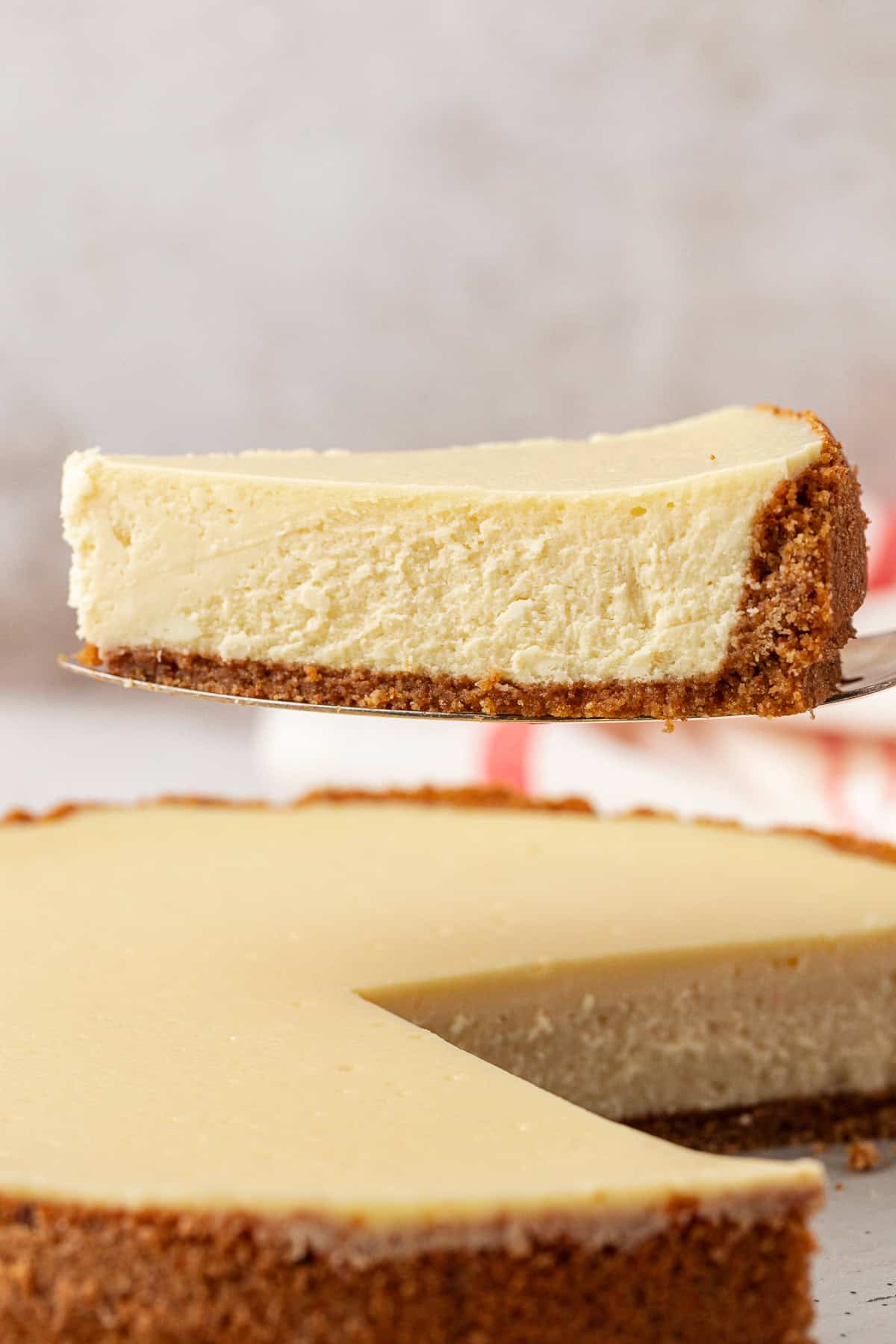
Complete with a buttery graham cracker crust, this timeless cheesecake is sure to impress your guests and earn rave reviews at every gathering. Whether you’re a seasoned baker or a beginner, you’ll create a dessert that’s as beautiful as it is delicious.
This is the absolute best recipe I’ve ever made! Most recipes leave my cheesecake with brown tops! Not this one! We use this in our cheesecake business. It also freezes really well!
-Stephanie
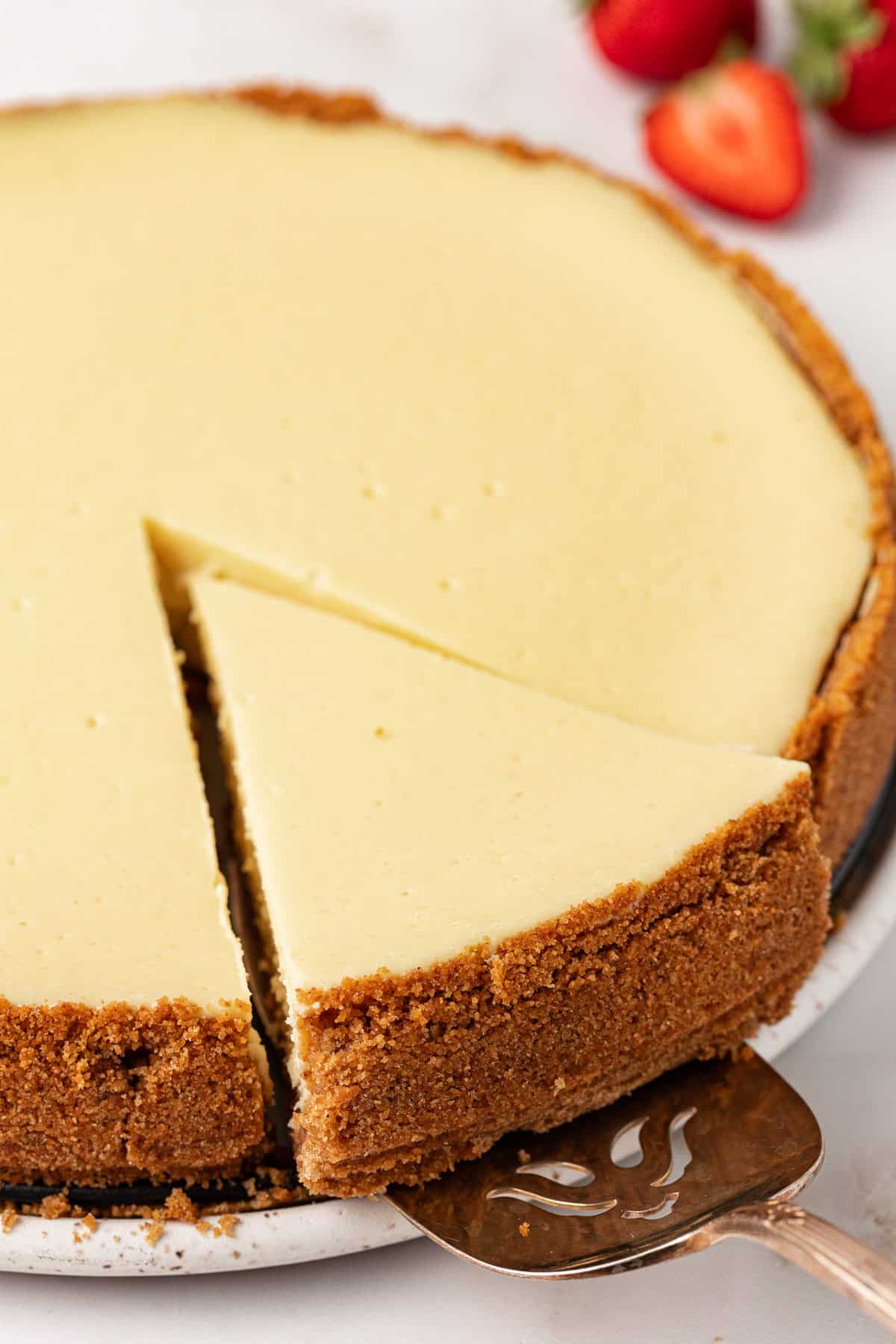
Why you’ll love this Classic Cheesecake Recipe
This cheesecake recipe is the perfect combination of simplicity and sophistication. With just four basic ingredients in the batter, it’s easy enough for beginners yet delivers bakery-quality results that will impress even the most discerning dessert lovers.
The step-by-step instructions, including tips for mastering a water bath, make it virtually foolproof. Whether it’s a holiday gathering or a casual dinner party, this cheesecake’s creamy texture, perfectly balanced sweetness, and buttery graham cracker crust are guaranteed to steal the show.
Plus, rave reader reviews prove it’s a recipe you can trust to wow every time!
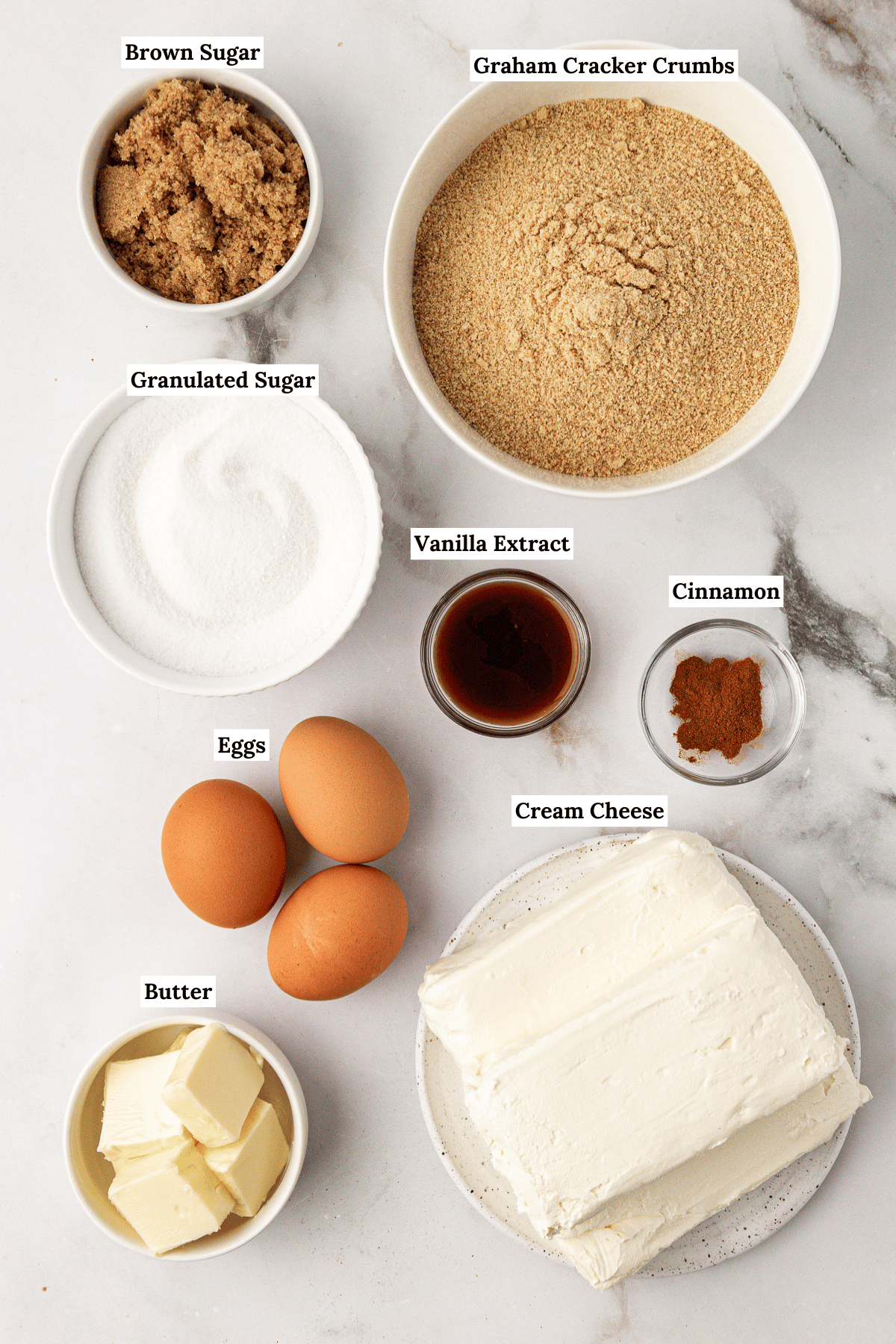
Homemade Cheesecake Ingredients
Our original cheesecake recipe only calls for 4 ingredients!
- cream cheese: use three 8 oz packages. Be sure to use full fat, not low fat, cream cheese for best results.
- sugar: helps to balance the tanginess of the cream cheese.
- vanilla extract: just a teaspoon, but it enhances the flavor.
- eggs: use large eggs. Eggs are the last ingredient that get mixed into the cheesecake batter. Be sure to mix them in, one at a time, just until the yolk breaks. Over beating the eggs is the number one cause of air bubbles and large cracks, which means there’s too much air in the cheesecake.
For the Graham Cracker Crust
- graham cracker crumbs: use store bought or make your own
- brown sugar: adds a deep rich flavor to the crust and helps to bind the crumbs and butter together
- cinnamon: adds a little warmth and spice without being overwhelming
- butter: this most crucial ingredient in binding the crust together
Cheesecake Recipe Pro Tip
Did you know you can buy a box of graham cracker crumbs in the baking aisle of your grocery store?
They are usually near the pre-made graham cracker pie crusts. I love using the store bought graham cracker crumbs because it saves time!
However, you can use whole graham crackers and blend them yourself in a blender or food processor until you get fine crumbs.
How to Make Graham Cracker Crust for Homemade Cheesecake
Everyone loves a buttery graham cracker crust, this is exactly how to make it!
Mix all the crust ingredients together and then firmly press the crust into the bottom and up the sides of the springform pan. Use the bottom of a measuring cup or bottom of a glass cup to help pack the crust.
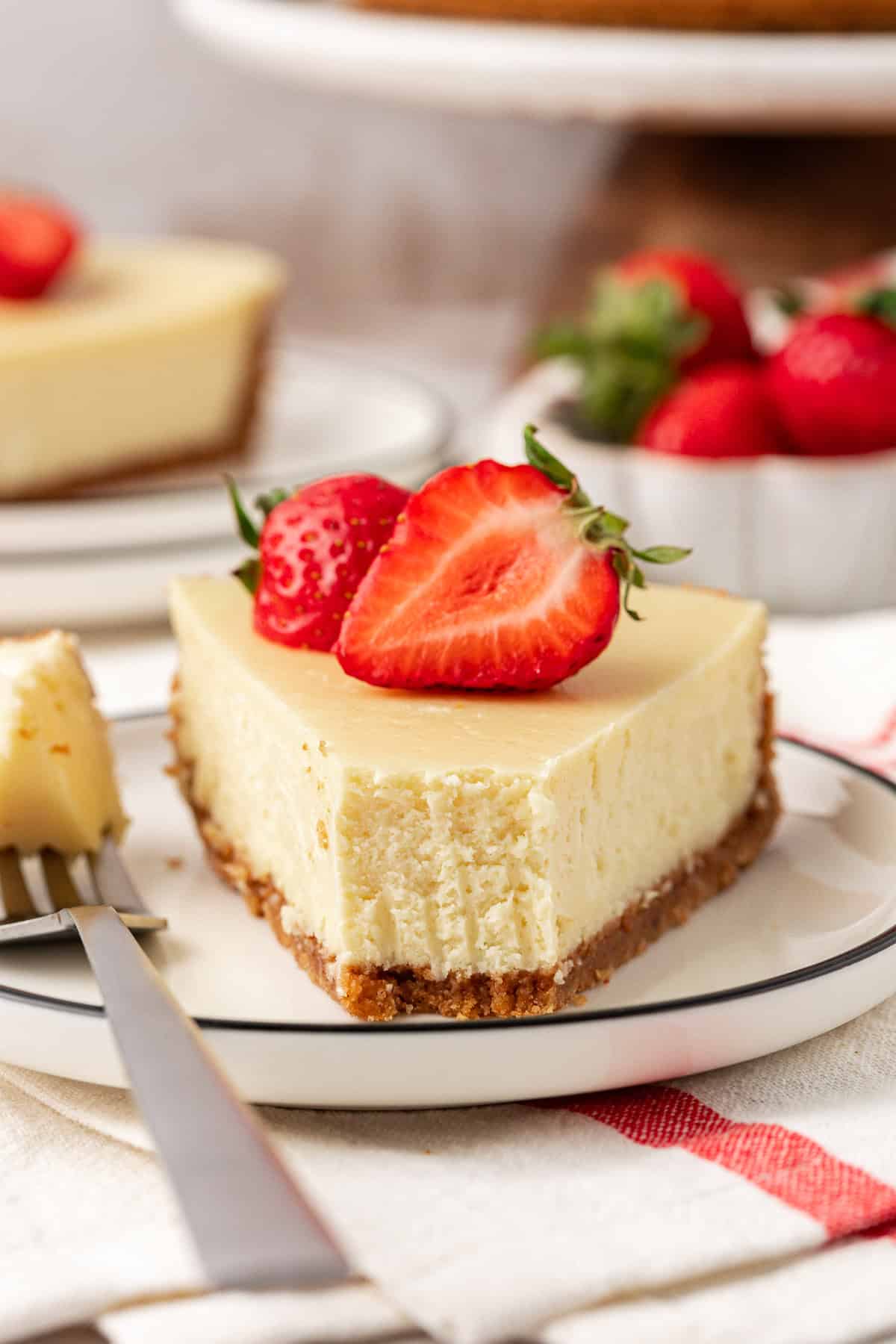
The Most Important Rule for this Cheesecake Recipe
Every single cheesecake recipe I have on my site, I include two critical tips. Here are the 2 most important details to follow when making cheesecake..
1. Don’t be afraid of the water bath
2. Don’t rush the cooling process
Keep reading below for details on each tip!
How to make Cheesecake
Crust
- In a small bowl, combine the graham cracker crumbs with the brown sugar, cinnamon and melted butter, mix well until incorporated.
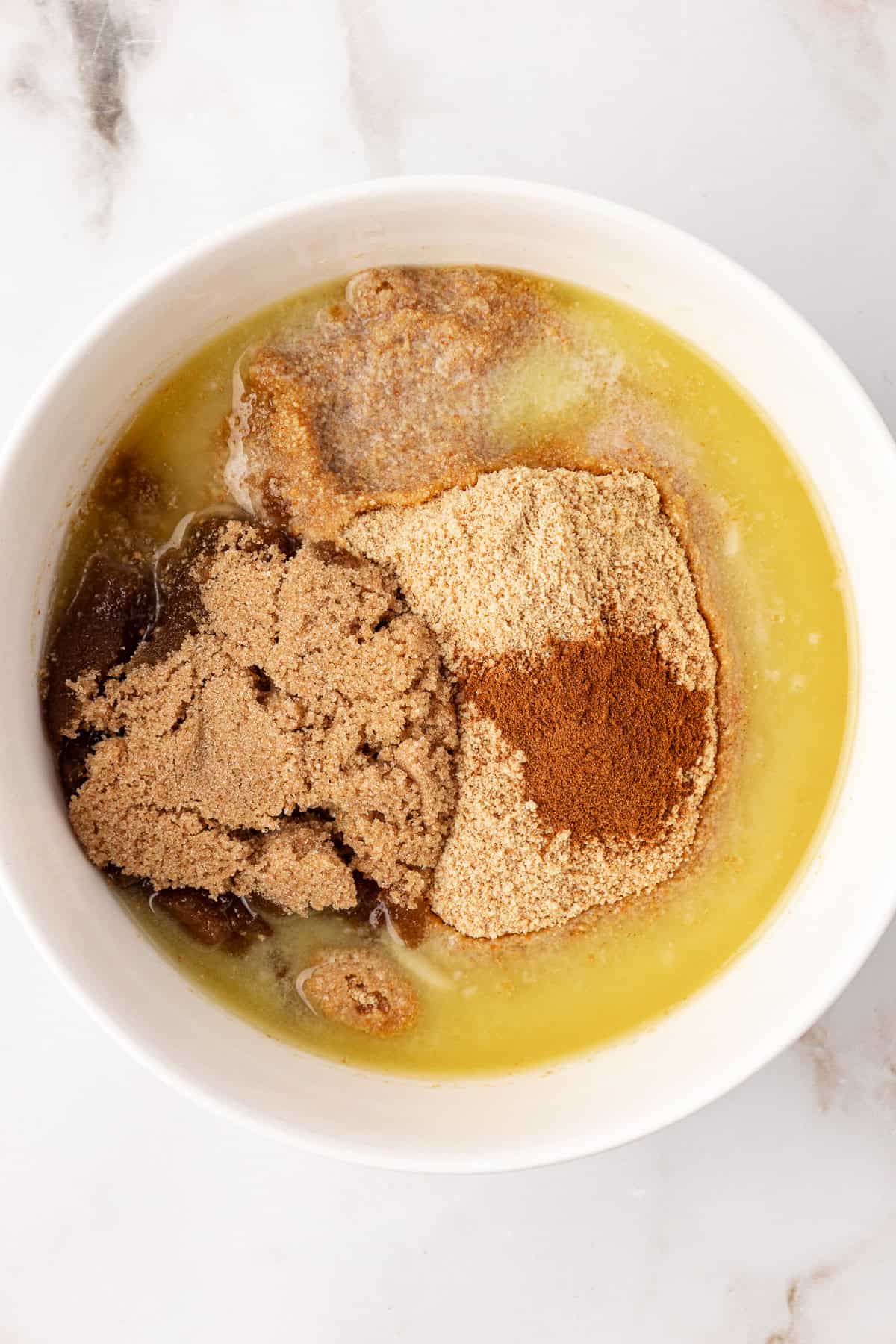
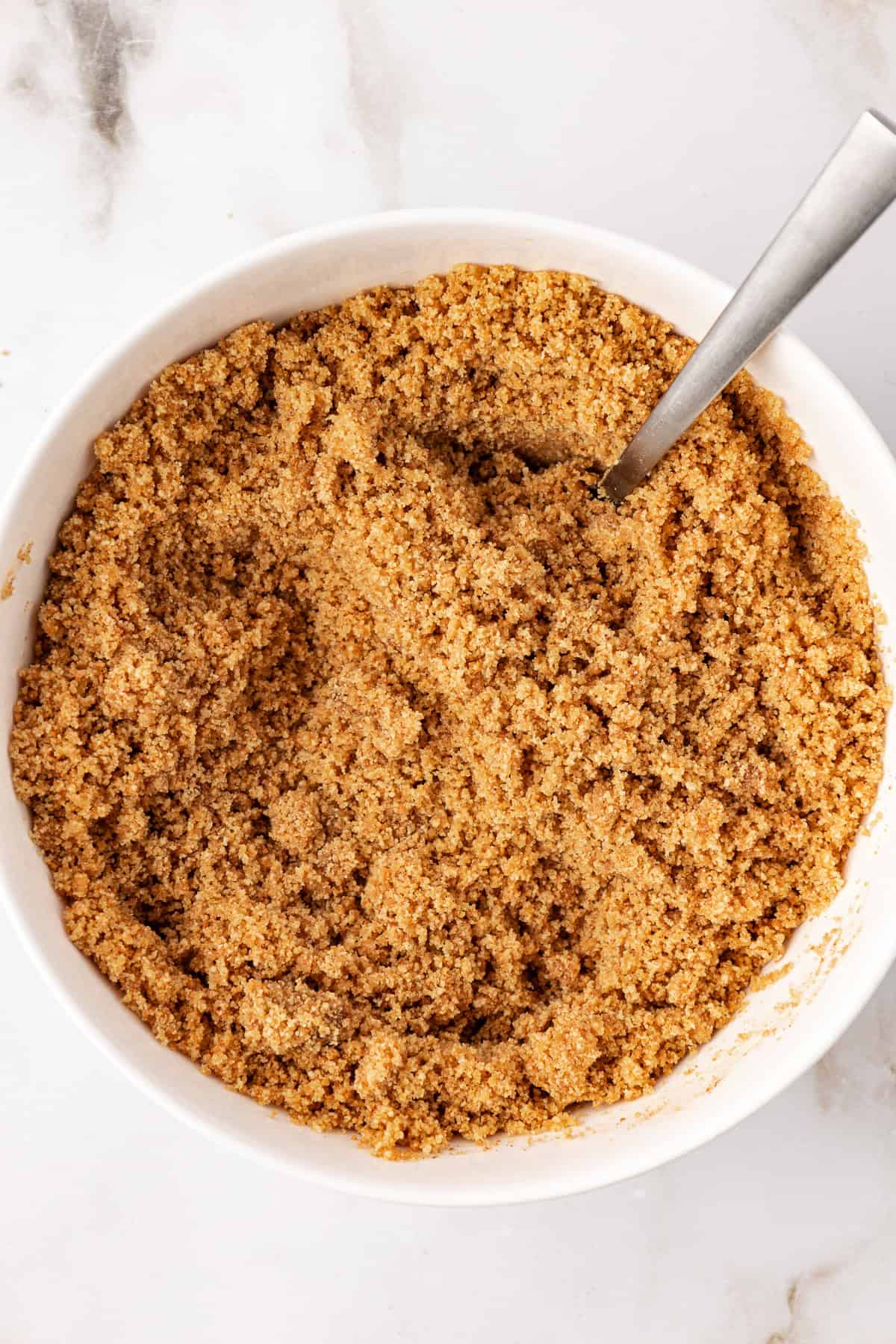
- Add the crumbs to a 8 or 9 inch springform pan, distribute them evenly, using a cup or the bottom of something flat to press the crumbs into the pan.
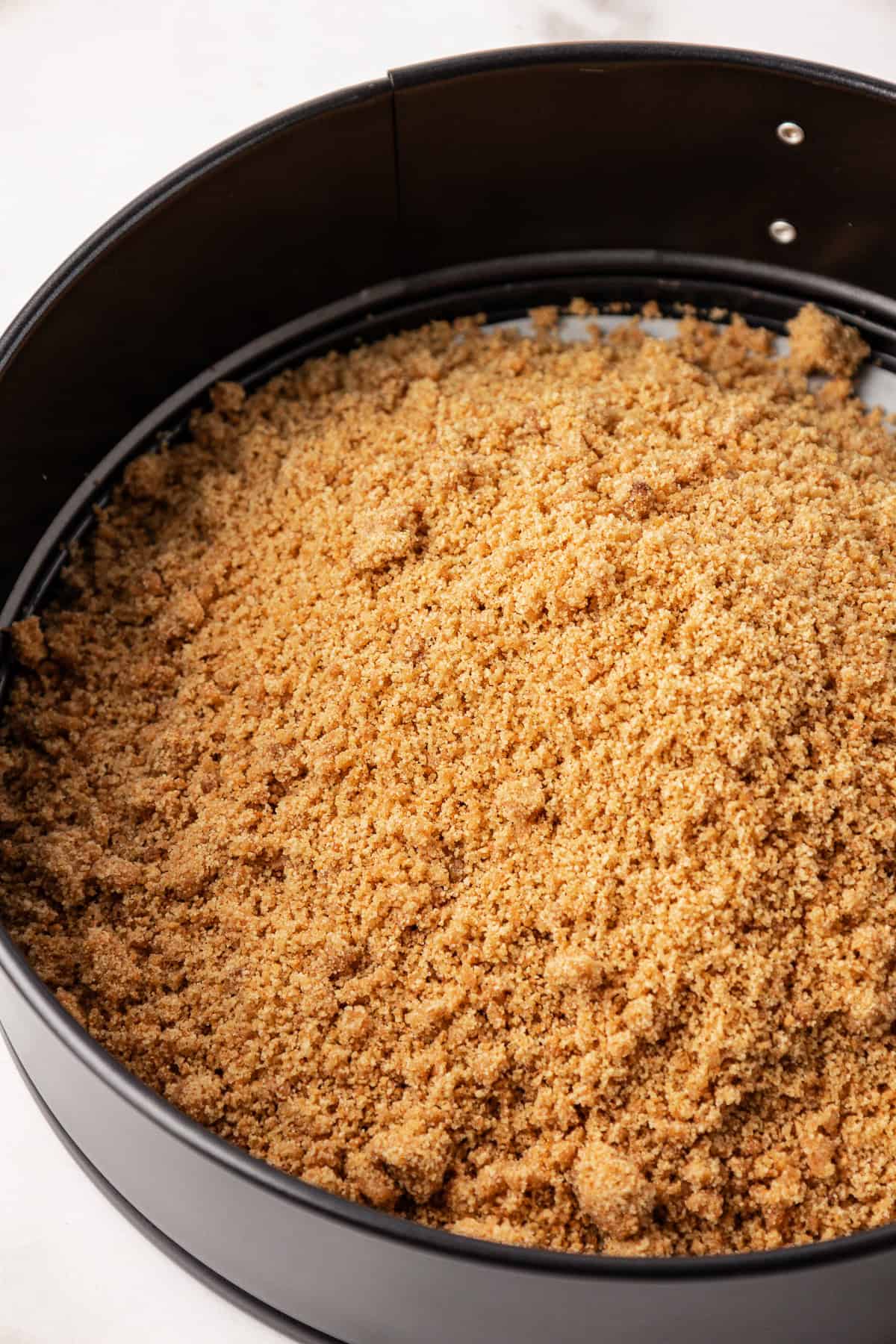
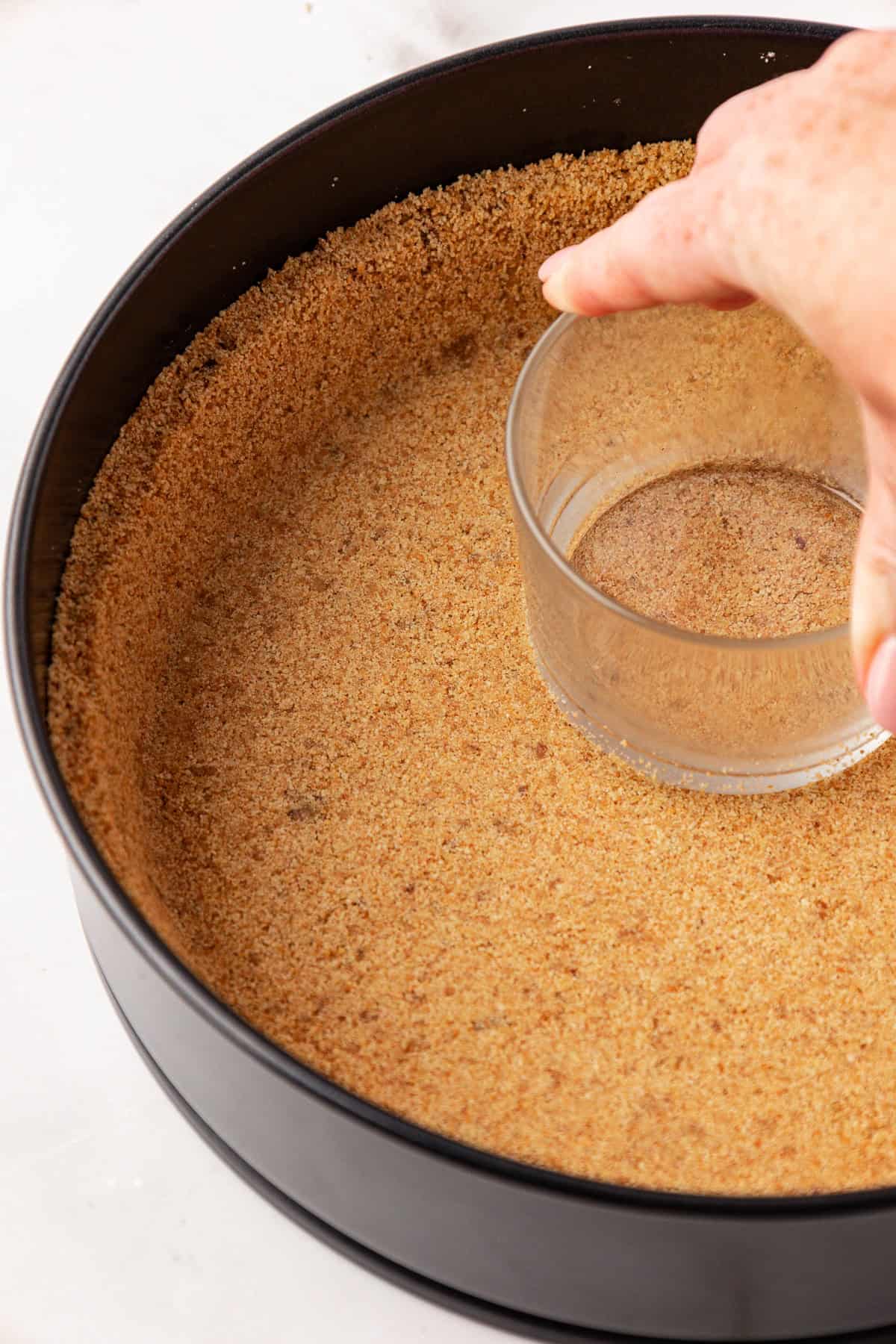
- Place the pan in the oven, pre-bake the crust for 8-10 minutes or until golden.
- Remove the pan from the oven, and allow it to cool to room temperature before adding the cheesecake mixture. Turn the oven down to 325ºF.
Cheesecake
- Place the round springform pan inside an oven safe bag (like one that you’d cook a turkey in for thanksgiving) or a slow cooker liner. Roll the top of the bag down so it doesn’t cover the cheesecake. Set aside.
- In a large mixing bowl, beat the 3 packages of cream cheese until smooth. Add in the sugar, and vanilla extract, beat again. Add in the eggs, mixing for 1 minute.
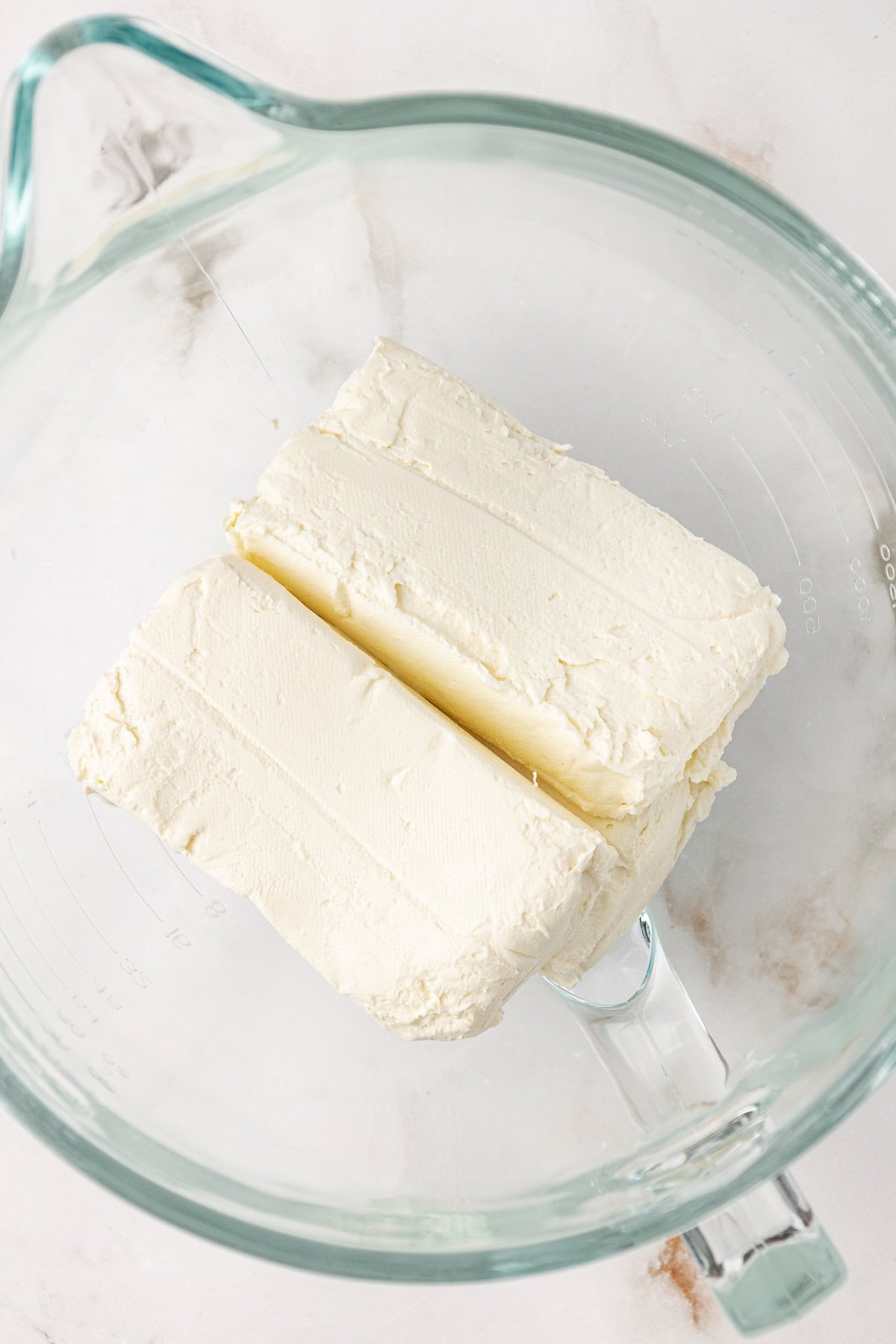
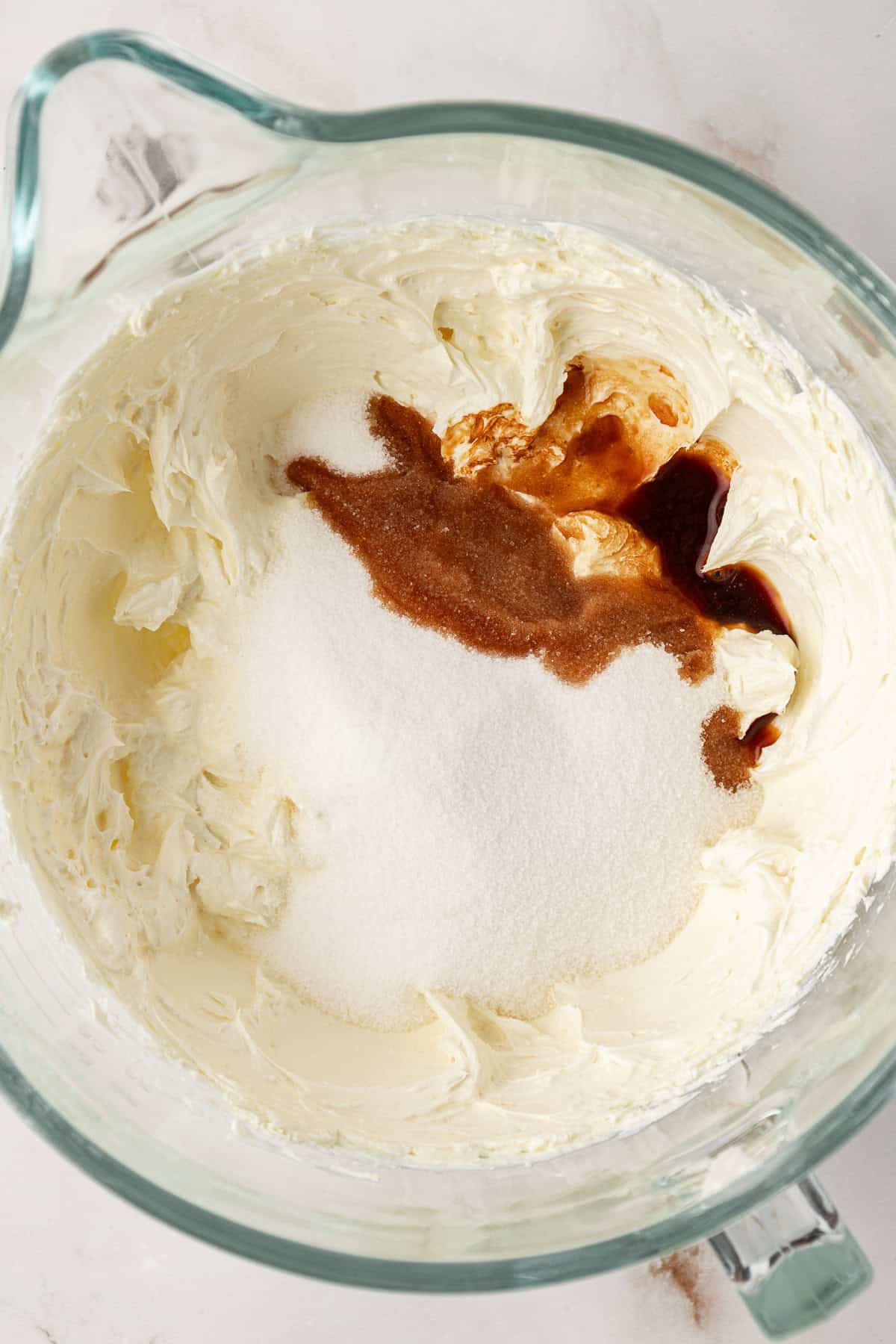
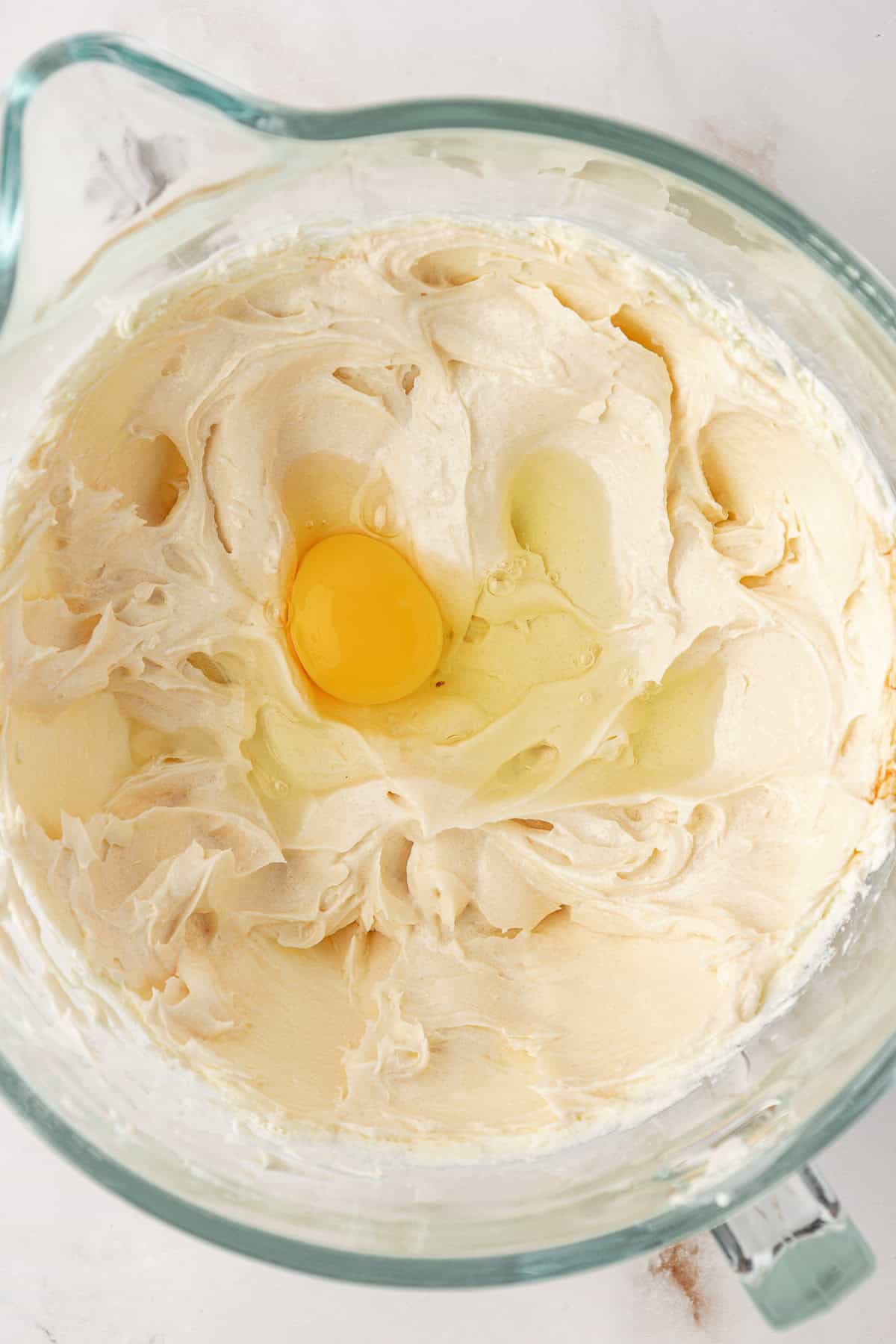
- Pour the cheesecake mixture on top of the cooled crust.
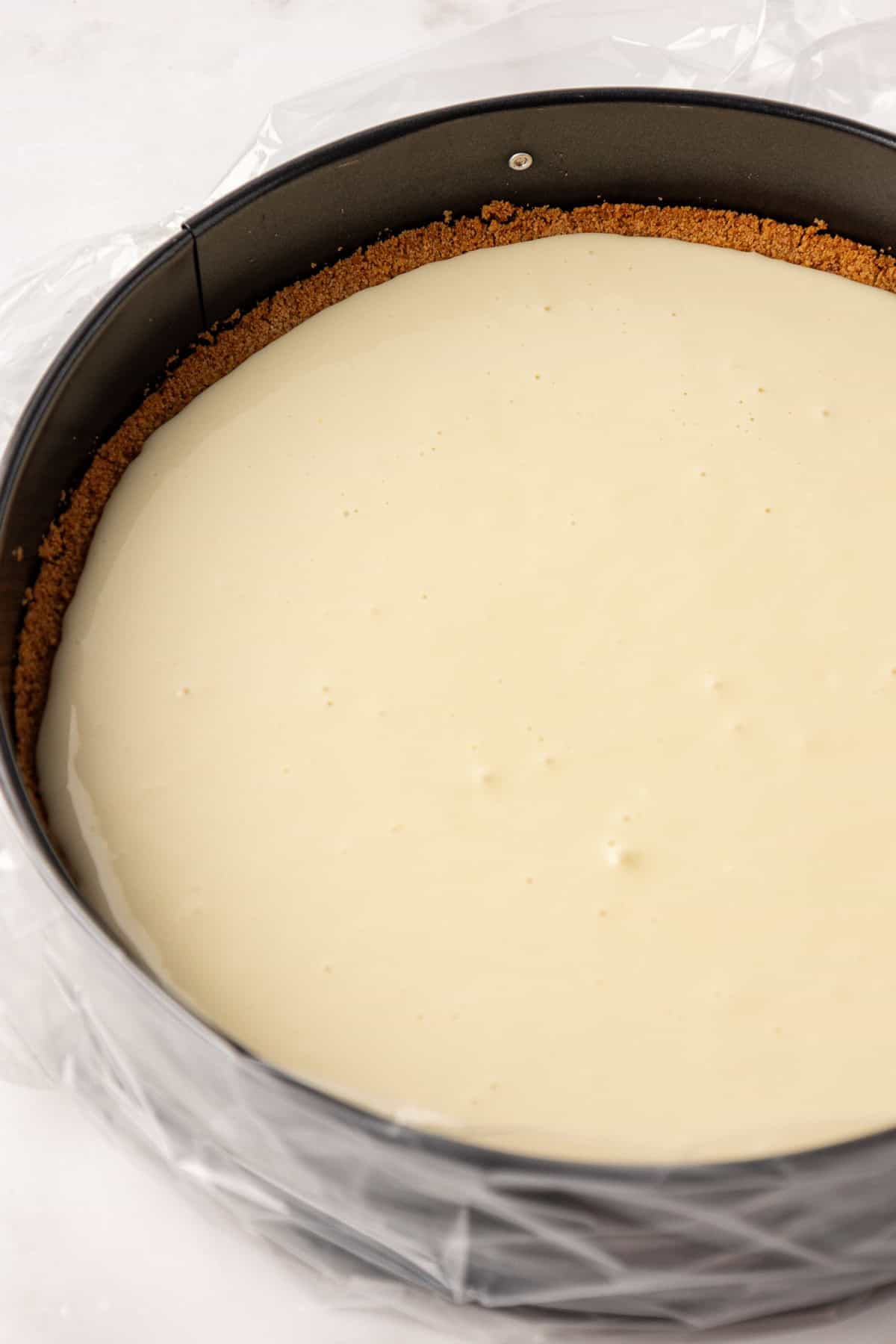
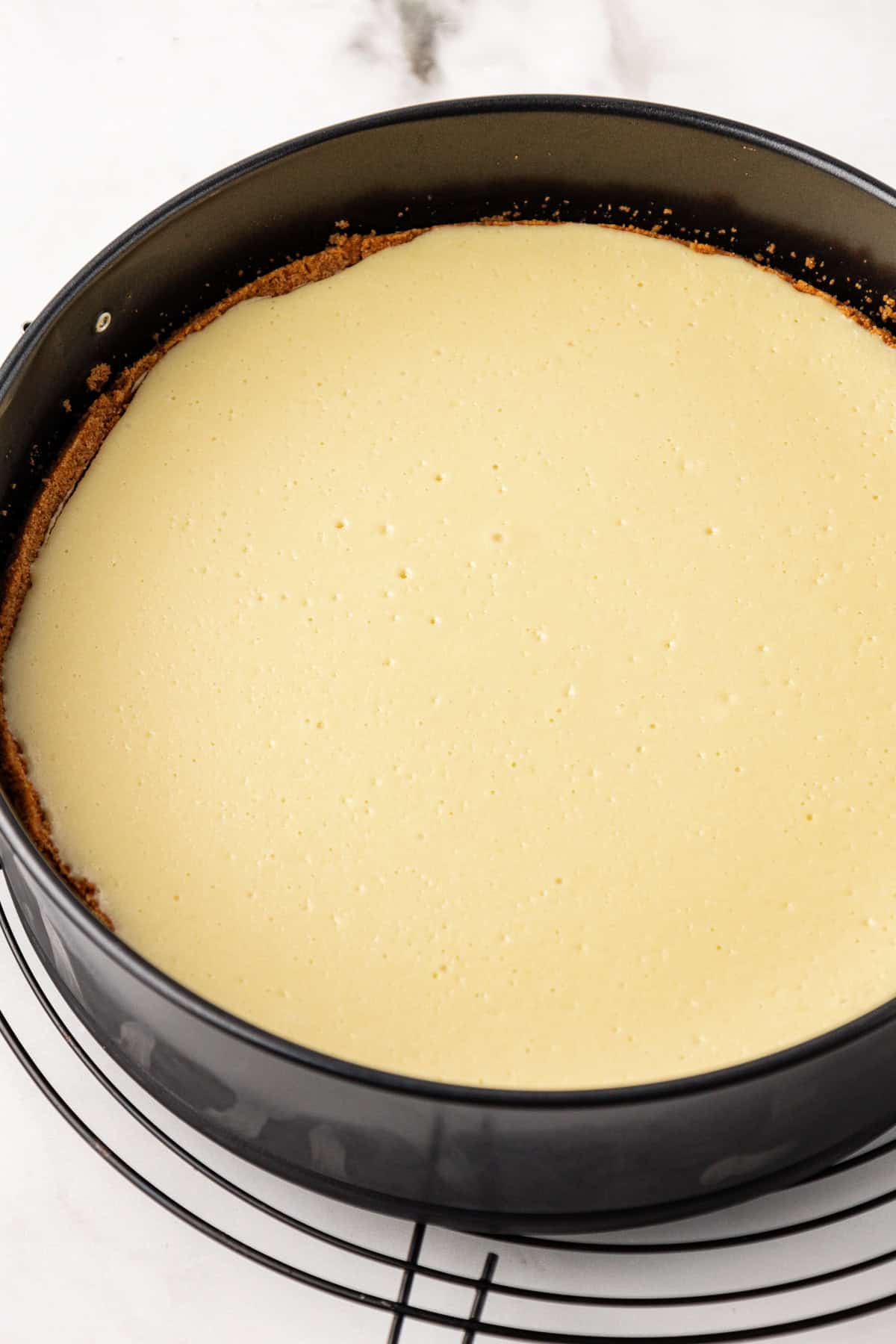
- Place the springform pan in a 9×13 inch pan or larger roasting pan. Carefully fill the roasting pan with about 1 inch of water.
- Place the water bath with the cheesecake inside in the oven and bake at 325º F for 60-70 minutes. The cheesecake is done when the center wobbles a little when you jiggle the pan. The edges of the cheesecake should look firmer than the center.
- Once the cheesecake is done baking, turn the oven off and gently remove the springform pan from the water bath and oven safe bag. Place the cheesecake on a baking sheet and return to the oven (oven is off) with the oven door cracked. Allow the cheesecake to cool to room temperature inside the oven before removing – this could be 60-90 minutes.
- Once cooled to room temperature, remove the cheesecake from the oven. Loosely cover the cheesecake with foil and place in the fridge overnight.
How to Make a Water Bath for Homemade Cheesecake
I know it sounds weird, putting your cheesecake in a water bath, but it’s the secret to creating moist, perfectly baked cheesecake. It’s really not scary.
Water bath basics
Place a springform pan inside a large cake or roasting pan, fill the roasting pan with about 1 inch of water and place in the oven.
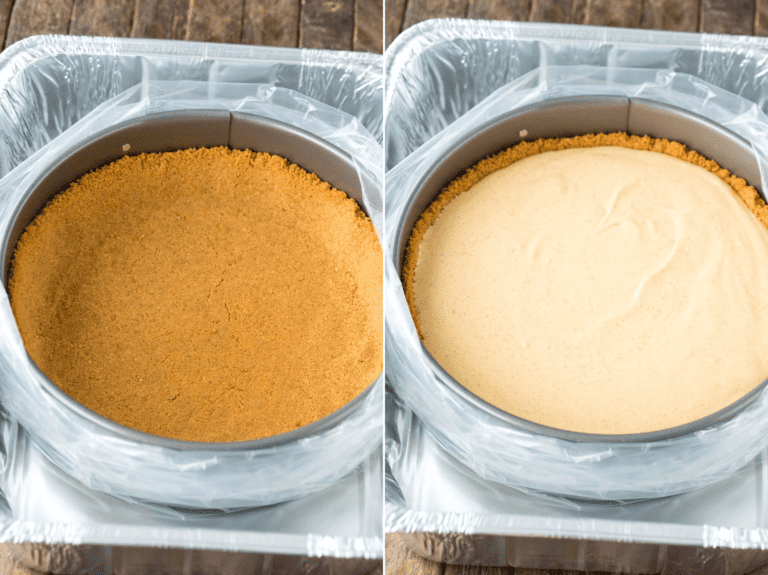
How to Prevent your Cheesecake Water Bath from Leaking
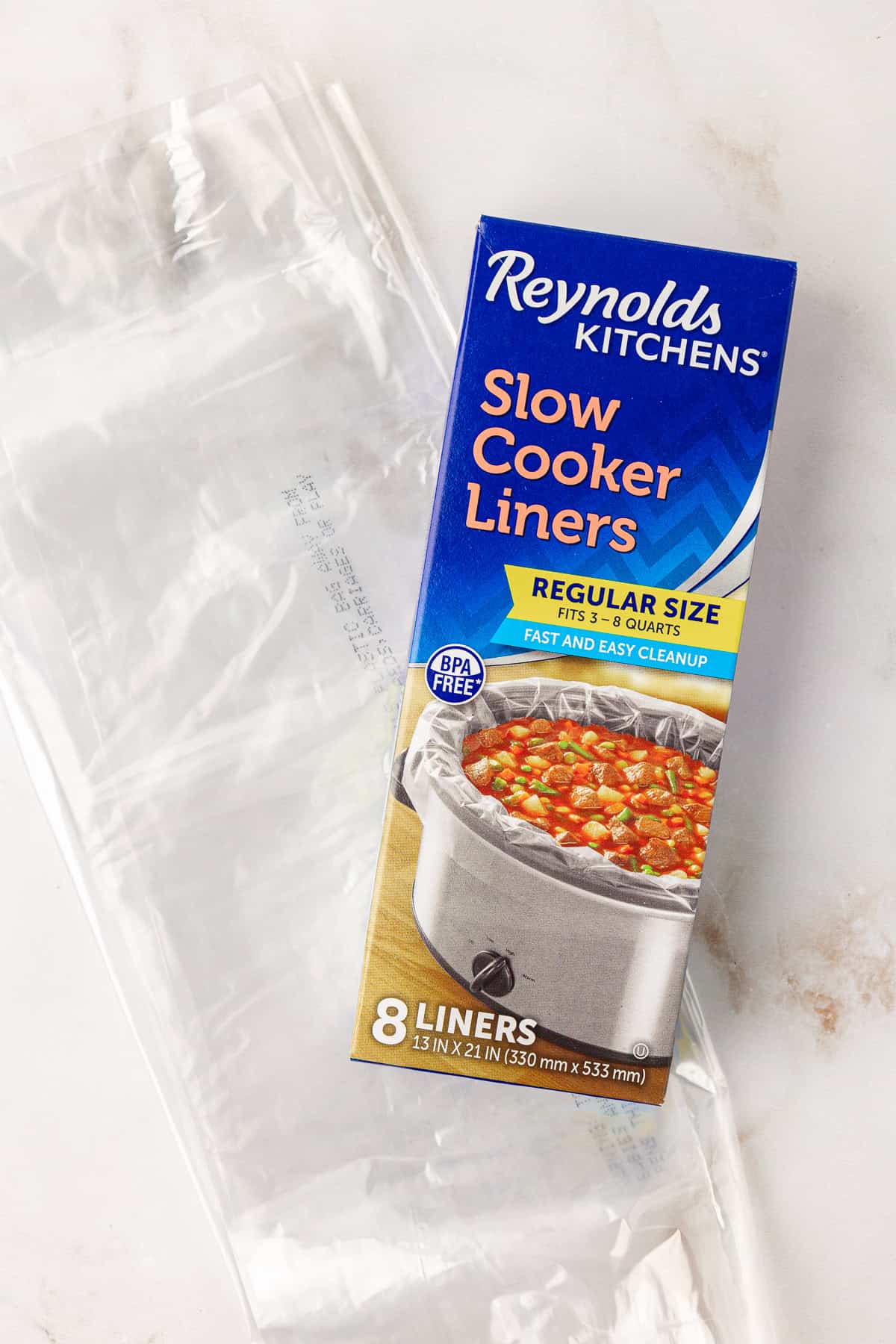
This is the best trick ever to prevent your cheesecake water bath from leaking and ruining your cheesecake.
Place the springform pan inside a large oven safe turkey bag or slow cooker liner bag and roll down the top of the bag so it doesn’t cover the cheesecake.
If you have a lot of excess bag space, twist one side tight and knot it so the bag is tight around the pan. Place the springform pan that’s inside the bag in the large roasting pan and fill with water.
The water bath will not leak into your cheesecake!
Why do you put a cheesecake in a water bath?
Putting a cheesecake in a water bath, also known as a “bain-marie” or “water bath,” serves a couple of important purposes during the baking process:
- Even and Gentle Heating: A water bath provides a gentle and even heat source for the cheesecake. The water absorbs and distributes heat, preventing the direct heat from the oven’s elements from hitting the delicate cheesecake mixture. This helps to ensure that the cheesecake bakes evenly without developing overcooked or cracked surfaces.
- Preventing Cracking: Cheesecakes are prone to cracking due to the drastic temperature changes and potential drying out of the surface during baking. The moist environment created by the water bath helps prevent rapid temperature changes and minimizes the chances of cracks forming on the surface of the cheesecake.
- Moisture Control: The steam generated by the water bath adds moisture to the oven, which reduces the likelihood of the cheesecake’s top becoming too dry and forming a hard crust. A moist environment contributes to a creamy and smooth texture.
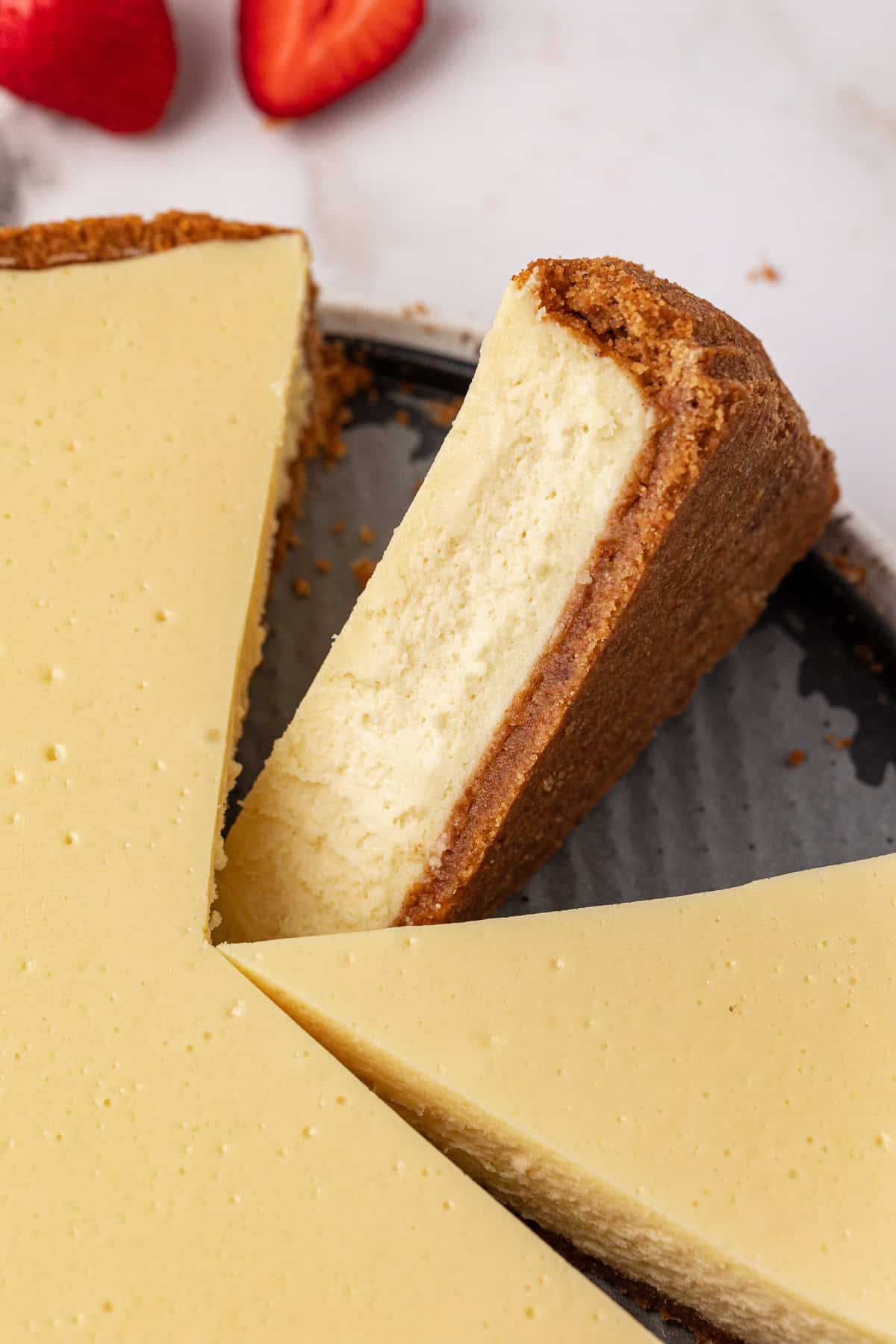
What happens if I don’t put my cheesecake in a water bath?
While it’s possible to bake a cheesecake without a water bath, using one is a common practice among bakers to achieve the best results. If you choose not to use a water bath when baking a cheesecake, a few potential outcomes can occur:
- Uneven Baking: Without the gentle and even heat distribution provided by a water bath, the cheesecake might bake unevenly. The edges could become overcooked or dry, while the center remains undercooked or too soft.
- Surface Cracking: Cheesecakes are more likely to develop cracks on the surface when baked without a water bath. Rapid temperature changes and drying out of the top layer can lead to unsightly cracks forming as the cheesecake cools.
- Texture Issues: The absence of the moist environment created by a water bath might result in a slightly drier and less creamy texture, especially on the top layer of the cheesecake.
- Less Smooth Appearance: A water bath helps ensure a smoother appearance on the surface of the cheesecake. Without it, you might notice a slightly rougher or uneven texture on the top.
Classic Cheesecake Recipe: How to Cool
Remember, don’t rush the cooling process.
Once the plain cheesecake is done baking turn the oven off and gently remove the springform pan from the water bath and oven safe bag. Place the cheesecake on a baking sheet and return to the oven (oven is off) with the oven door cracked.
A slow cooling process will help prevent the cheesecake from cracking. Don’t forget to refrigerate your cheesecake over night before serving.
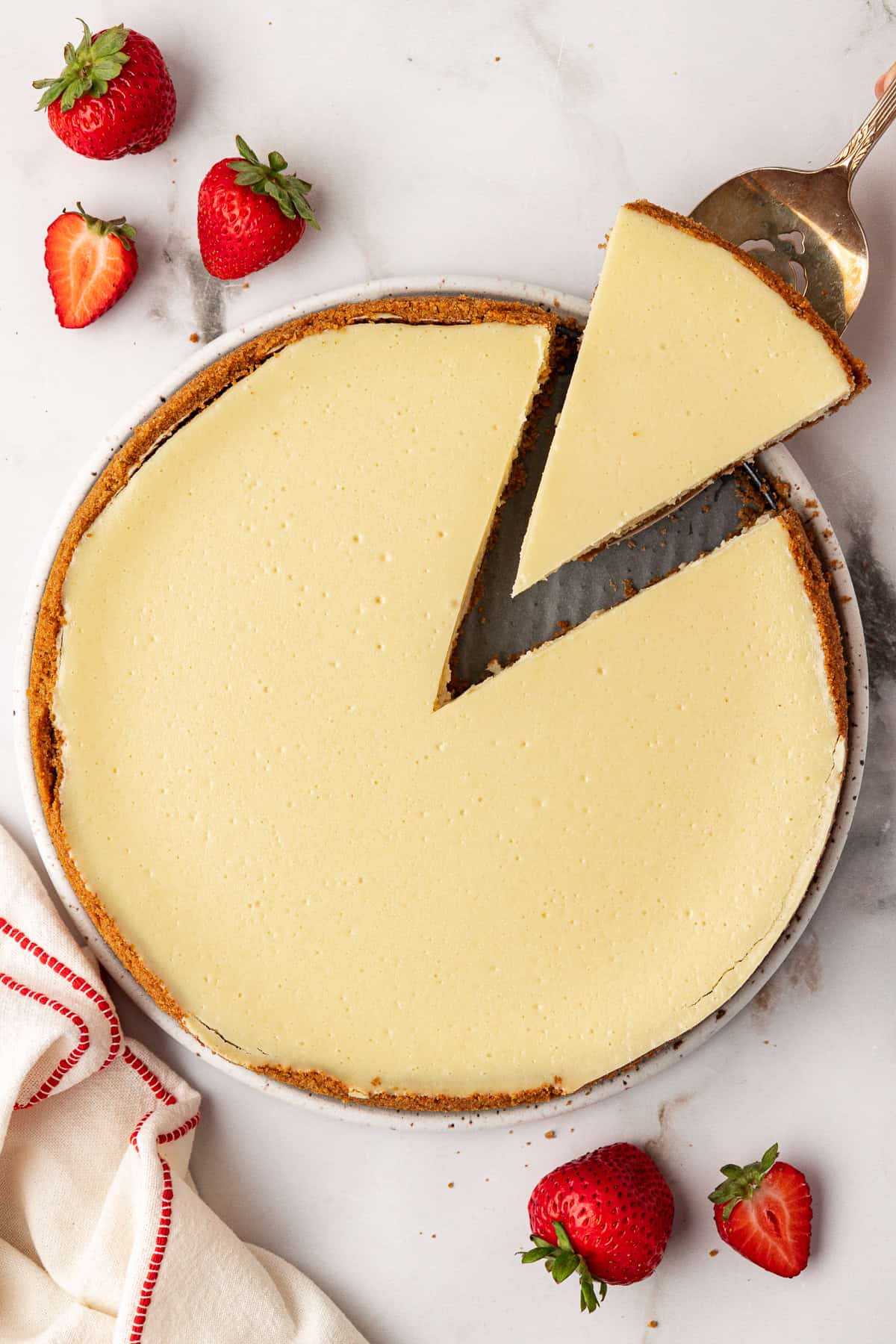
Best Cheesecake Recipe Tips
- Allow the cream cheese to come to room temperature before beating it. Room temperature cream cheese is easier to whip.
- The eggs are the last ingredient that get mixed into the cheesecake batter. Be sure to mix them in, one at a time, just until the yolk breaks. Over beating the eggs is the number one cause of air bubbles and cracking.
- Using a different size springform pan will alter the baking time. I used a 8 inch springform pan.
- Allow the cheesecake to cool in the oven (with the door cracked) for 1 hour.
How to tell if Cheesecake is Done
To determine when a cheesecake is done baking, follow these steps:
Check the Edges: Gently jiggle the cheesecake pan. The edges of the cheesecake should be set and firm, while the center may still have a slight jiggle.
Check the Center: Insert a toothpick or a thin knife into the center of the cheesecake, about an inch from the edge. It should come out mostly clean with a few moist crumbs clinging to it. The center should not appear liquidy or runny.
Check the Temperature: If you have an instant-read thermometer, insert it into the center of the cheesecake. The internal temperature should be around 150-155°F (65-68°C) when it’s done.
Look for Light Baking: The cheesecake should be slightly puffed and have a light golden color on top. Avoid overbaking, as this can lead to cracks or a dry texture.
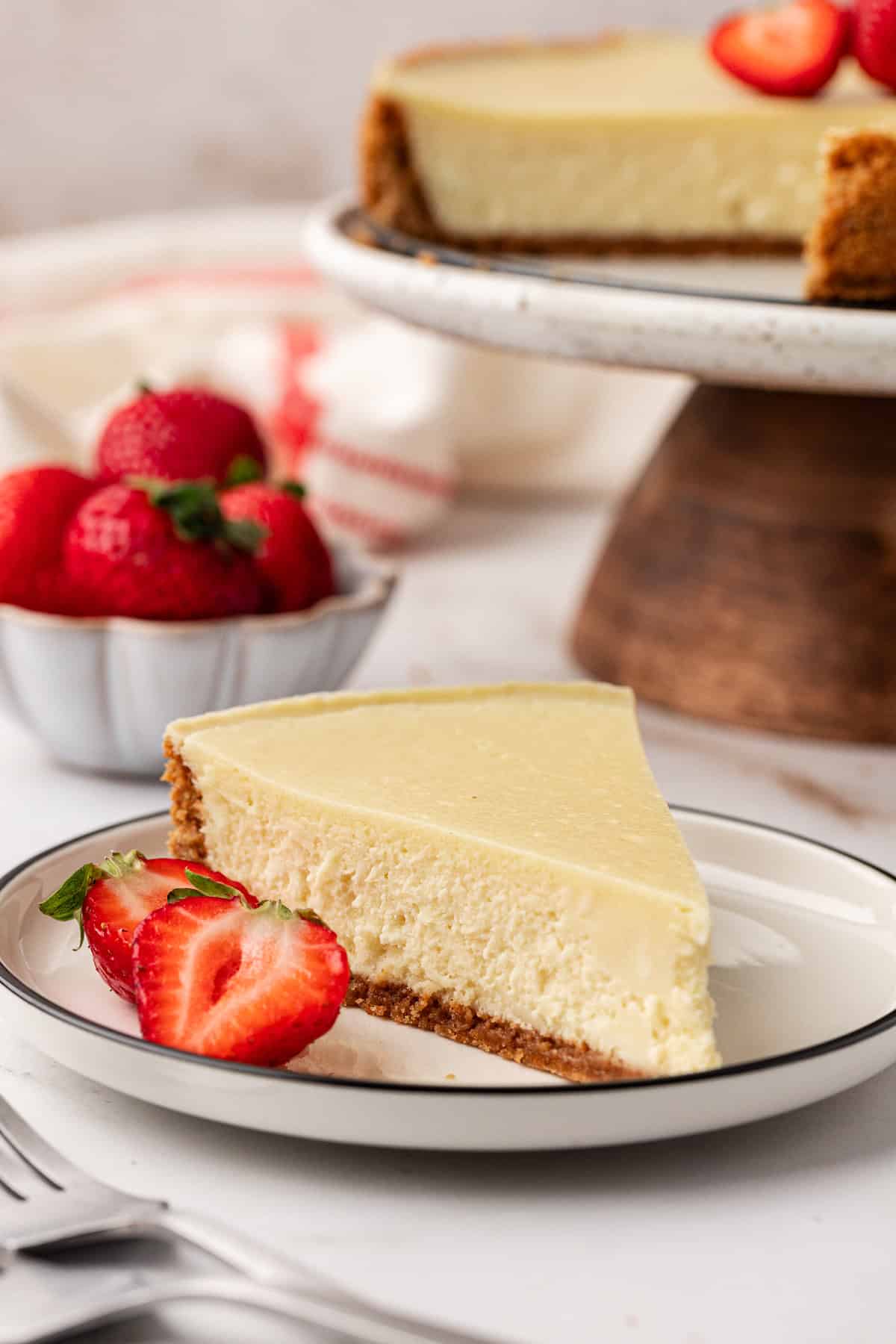
Storing This Recipe for Cheesecake
Store cheesecake in the refrigerator, preferably covered with plastic wrap or an airtight container to prevent drying out and absorbing odors. If your cheesecake has a fruit topping, add it after the cheesecake has been refrigerated. Cheesecake can typically be stored for up to 5 days.
How to Freeze a Whole Cheesecake
- Cool the cheesecake completely before freezing. You can allow it to cool on the counter or you can place it in the fridge over night to chill before freezing.
- Use a knife to remove the outer springform ring. Use the knife to gently remove the cheesecake from the bottom of the pan. Place the cheesecake on a round cardboard circle that’s been covered in aluminum foil. Make sure the cardboard circle is the same size as the cheesecake.
- Wrap the entire cheesecake (without any toppings) well in plastic wrap. Then wrap the cheesecake in aluminum foil for extra protection. Place in the freezer for up to 3 months.
- To thaw, place the cheesecake in the fridge overnight. Add toppings before serving.
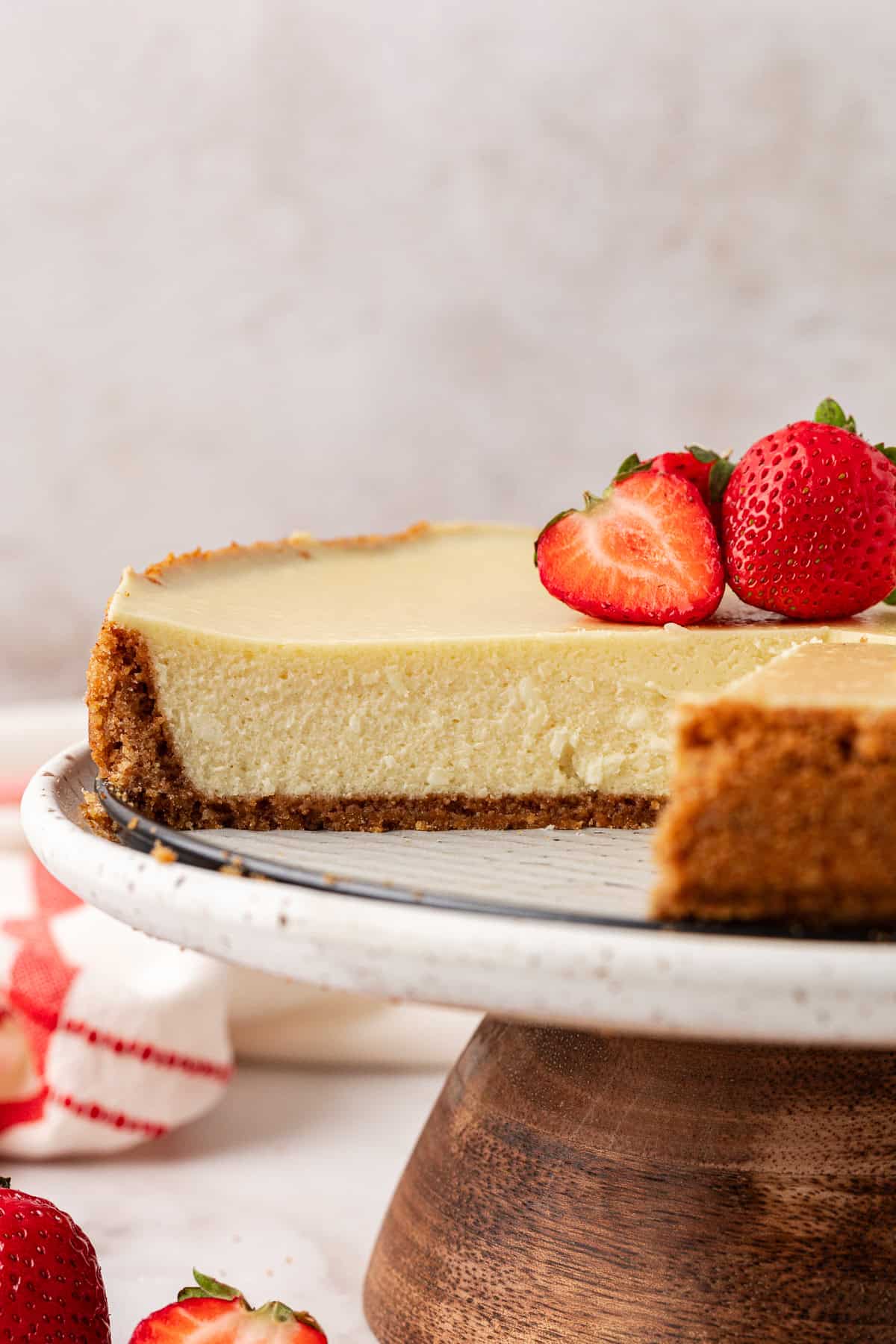
Toppings for this Homemade Cheesecake Recipe
- fresh fruit (strawberries, blueberries, blackberries, raspberries, mango, pineapple, etc.)
- chocolate ganache (follow the ganache recipe from our espresso cheesecake)
- caramel sauce
- strawberry sauce
- chocolate whipped cream
- crushed candy pieces (like peanut butter cups, M&Ms, snickers, etc)
Classic Cheesecake Recipe FAQs
The main difference between New York-style cheesecake and regular cheesecake lies in their texture and ingredients. New York-style cheesecake is known for its rich and dense texture, achieved by using cream cheese as the main ingredient and often sour cream or heavy cream for added richness. It’s typically baked in a high crust, resulting in a tall and creamy cake. Regular cheesecake, while also using cream cheese as a base, might have variations like ricotta or cottage cheese and can have a lighter texture. It may also have different regional styles and variations based on the type of cream cheese used and additional ingredients.
There are many types of cheesecake, but three common categories include:
New York-style Cheesecake: Known for its dense and creamy texture, New York-style cheesecake is made with cream cheese, often with sour cream or heavy cream. It has a rich flavor and is typically baked in a high crust.
Italian-style Cheesecake: This type often uses ricotta cheese as a primary ingredient, resulting in a lighter and slightly grainier texture compared to cream cheese-based cheesecakes. It’s also typically less sweet and might include citrus zest or liqueurs for flavor.
No-Bake Cheesecake: This type doesn’t require baking and is set in the refrigerator. It’s usually made with cream cheese or a mix of cream cheese and whipped cream, creating a light and airy texture. It’s often simpler to prepare and can have various flavorings and toppings.
Cream cheese is the most common and widely used cheese for making cheesecake. It provides the creamy and smooth texture that’s characteristic of cheesecake.
Avoid over-mixing the batter, skipping the water bath for even baking, opening the oven door during baking, using cold ingredients, and rushing the cooling process. These actions can lead to cracks, uneven texture, and other undesirable outcomes in your cheesecake.
More Dessert Recipes
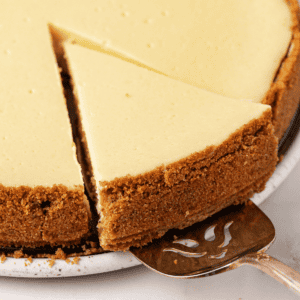
Tap stars to rate!
Homemade Cheesecake Recipe
Ingredients
Crust
- 2 cups (220-230g) (14-16 crackers) graham cracker crumbs,
- ¼ cup (54g) brown sugar
- ¼ tsp cinnamon
- 6 Tbsp (86g) unsalted butter, melted
Cheesecake
- 24 oz (678g) full-fat cream cheese , room temperature
- 1 cup (198g) granulated sugar
- 1 tsp vanilla extract
- 3 large eggs
- One oven safe turkey bag, see instruction #2 under cheesecake

Instructions
Crust
- Preheat the oven to 350°F. If using whole graham crackers, pulse or blend them into crumbs.
- In a small bowl, mix the graham cracker crumbs, brown sugar, cinnamon, and melted butter. Transfer the mixture to an 8 or 9-inch springform pan. Use the bottom of a cup to evenly distribute and pack the crumbs. If desired, press some crumbs up the sides of the pan.2 cups (220-230g) (14-16 crackers) graham cracker crumbs, 1/4 cup (54g) brown sugar, 1/4 tsp cinnamon, 6 Tbsp (86g) unsalted butter
- Bake the crust in the oven for 8-10 minutes, or until golden. Remove the pan and allow it to cool to room temperature. Reduce the oven temperature to 325°F.
Cheesecake
- In a stand mixer or using a hand mixer, beat the cream cheese, granulated sugar, and vanilla extract until smooth, about 2-3 minutes.24 oz (678g) full-fat cream cheese, 1 cup (198g) granulated sugar, 1 tsp vanilla extract
- Add the eggs one at a time, beating just until combined. Mix for an additional minute, being careful not to overmix. Pour the cheesecake mixture over the cooled crust.3 large eggs
- Place the springform pan inside an oven-safe bag and roll down the top to prevent it from covering the cheesecake. Alternatively, tightly wrap the outside of the pan with three large sheets of heavy-duty aluminum foil to prevent water from leaking in.One oven safe turkey bag
- Set the springform pan in a large roasting pan and carefully fill it with about 1 inch of water.
- Bake the cheesecake in the water bath for 60-75 minutes. It's done when the center wobbles slightly when jiggled, and the edges appear firmer than the center.
- Once baked, turn off the oven and gently remove the springform pan from the water bath and oven-safe bag. Place the cheesecake on a baking sheet and return it to the turned-off oven with the door cracked. Let it cool to room temperature for about 1-2 hours.
- After cooling, remove the cheesecake from the oven. Loosely cover it with foil and refrigerate overnight.
- To Serve: Before serving, carefully unmold the cheesecake from the pan, using a small spatula to assist with any sticking parts. The cheesecake should naturally separate from the pan. Add your desired toppings, cut, and serve.
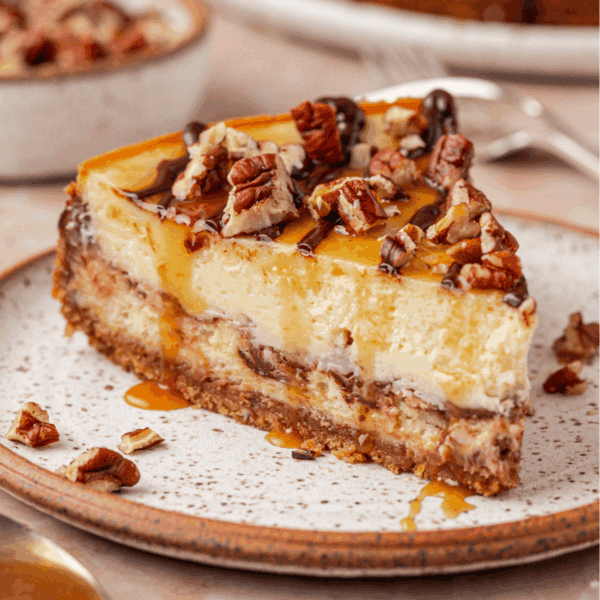
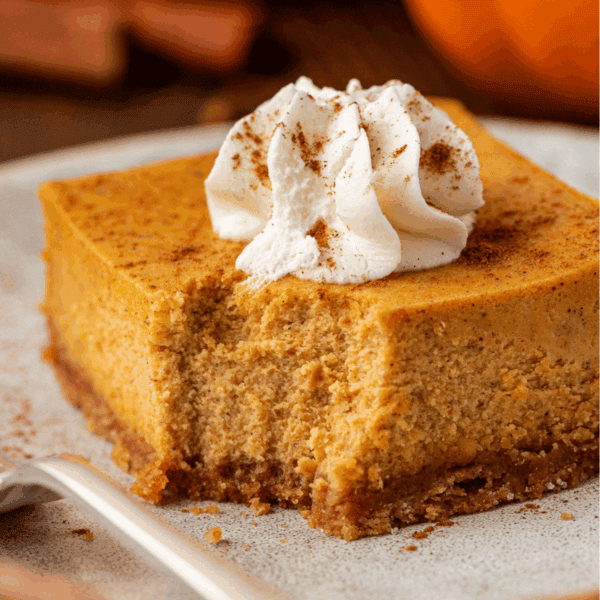
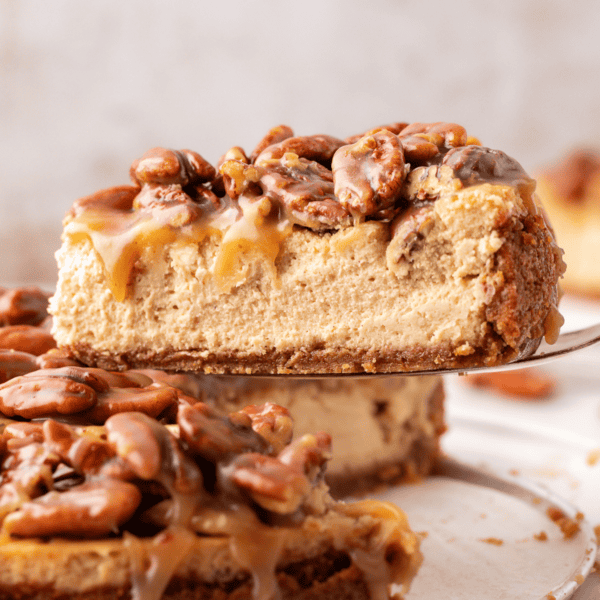
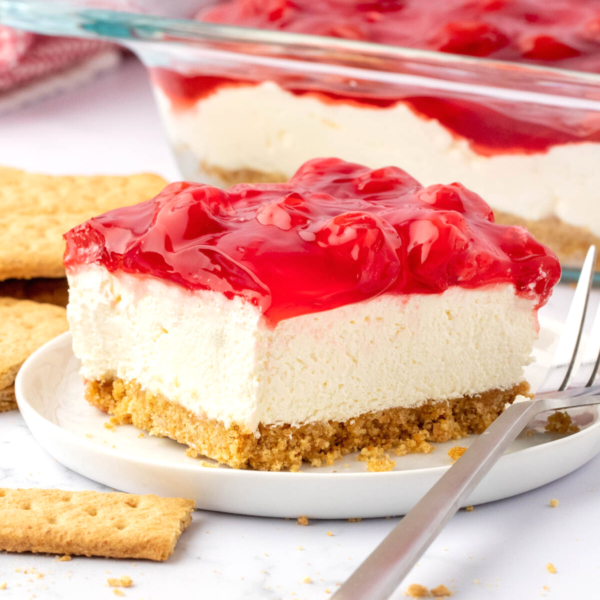






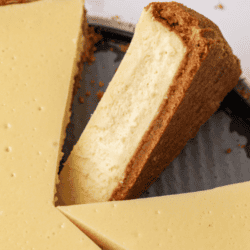
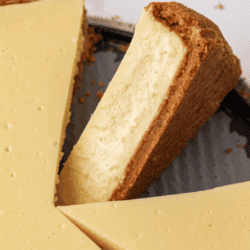
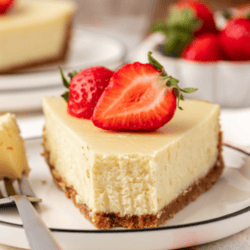
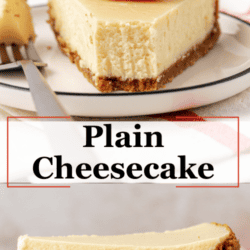
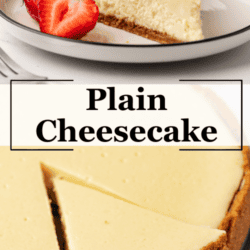
What do I put over the cheesecake while it is in the fridge overnight?
I would suggest covering it in plastic wrap and placing it in a ziplock bag!
Love this recipe! Easy to make, the hardest part is to wait =)
Haha, I understand that for sure! Thank you!
This cheesecake was amazing! We love the crust it tastes like restaurant quality and cinnamony, if thats a word. Very creamy too. We loved it.
Hi Beth, please can you tell me if I wanted to add sour cream to the recipe how i would adapt that to the recipe? Thank you!x
Hi Zai! I don’t have a recipe for a sour cream based cheesecake, my apologies!
I don’t have a springform pan. I hope lining the sides of a Wilton 9″ cake pan with parchment paper will work. I saw it on another recipe. Fingers crossed.
Hi Beth, can a 6 or 7 inch pan be used for this recipe?
I probably wouldn’t suggest a 6 inch, I think the filling would over fill the pan. A 7 inch might be okay – the bake time would be longer.
Awesome recipe! First cheesecake I’ve made that did not crack. And it was the perfect taste & consistency!!
Merry Christmas! I used this recipe on a whim for Christmas dessert and it was awesome. I only had 2 blocks of cream cheese a an 8 oz. container of soft cream cheese (not whipped) so that is what I used. Thank you Beth!!
Hola, do you have a recipe / adjustment for 2 packs of cream cheese?
No, sorry!
Baked this today and it was fantastic! I only waited about 4-5 hours for it to cool before serving and it was perfect. Thank you!